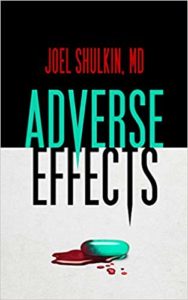Although Robin Cook’s 1977 novel Coma is widely considered the first medical thriller, authors have been writing medical fiction for far longer than that. Medical scenes captivate readers as physicians rush to save lives and identify lethal illnesses with near-magical ability. But the complexity of modern medicine—even for authors with a medical background—makes it difficult at times to suspend disbelief in the name of a thrilling story.
In 1904, an editor at the Journal of the American Medical Association wrote about a recent Sherlock Holmes story: “It seems to be the rule, unfortunately, for writers of fiction, when dealing with medical subjects, to pay no attention to facts. This leads to the most ludicrous combinations of symptoms and to descriptions of conditions that cannot exist…In dealing with medical subjects, why do not writers of fiction properly inform themselves and so avoid making such ridiculous errors?”
More than a hundred years later, lightspeed advances in biotechnology and medical knowledge have inspired fantastical story ideas, yet many authors continue to make the same mistakes in writing medical scenes. These are the most common ones to avoid.
Role Confusion
Nothing can pull a reader out of the story more than when a character is out of character. This includes how they do their job. If I see a psychologist prescribing medications (this is the role of a psychiatrist), or a cardiologist doing open-heart surgery (instead of a cardiothoracic surgeon), it dispels any sense of believability. Similar problems include portraying registered nurses who operate independently of physicians, and doctors who do everything on their own (including operating MRI machines and running complex lab tests).
Diagnosis without Evidence
While an astute clinician can make some “eyeball” diagnoses from obvious symptoms, most require some sort of diagnostic evaluation. For example, if a patient goes into cardiorespiratory arrest, there are no physical signs to differentiate ventricular fibrillation from another cause of arrest; an EKG monitor has to identify the rhythm.
And unless your doctor is Kryptonian, they’ll need an X-ray to diagnose a stress fracture.
Treatment and Response Time
Using correct diagnostic equipment to confirm the diagnosis is critical in medicine because some treatments may not be effective for conditions that have similar symptoms to others. For example, in the V-Fib case above, cardioversion would be an appropriate treatment. But contrary to what nearly every medical drama would have you believe, shocking asystole (also known as “flatline”) is not only ineffective—it can cause damage to the heart.
Interventions have varying effect times. Even a fast-acting sedative takes at least five minutes to work, so you won’t see a belligerent patient suddenly slump and calm seconds after being injected. And it’s important to know how medications are administered, and that the way they’re delivered affects speed of onset. For example, insulin cannot be injected intramuscularly, but epinephrine can (and not directly into the heart).
How many movies show the hero digging a bullet or arrowhead out of their leg and then continuing to fight? In real life, removing a foreign body would cause more bleeding, which is why it’s done in an operating room. Even if a bullet goes “through and through” without hitting major organs, it’s likely to hit some larger blood vessels or damage some muscle, requiring some effort to stop the bleeding and provide pain control.
It’s important to ensure that the technique used is appropriate for treating the problem, and that the character is properly trained to perform it.
Recovery from Injury/Illness
It’s also important to consider how long it takes someone to recover from injury or illness. A patient would not be able to have a conversation right after a heart attack. A head injury significant enough to cause loss of consciousness would take longer than a mere few minutes for that person to be able to function. Someone rescued from a near-drowning wouldn’t be fully recovered simply by coughing out water.
Conversely, most people won’t fall to the ground dead the moment a bullet strikes them.
Even with a gunshot wound to the head, it takes at least five minutes to “bleed out;” breathing and circulation wouldn’t suddenly stop either unless the brainstem was severely damaged.
Portrayal of Mental Health
An unfortunate trope is the mentally unstable antagonist. As a matter of fact, most individuals with mental illness are not violent and are themselves at higher-than-average risk of being a victim. For more information on accurate representation of psychiatric conditions in fiction, please refer to my article in Suspense Magazine: “Writing Thriller Protagonists with Psychiatric Conditions.”
Lack of Consequences
Shows like House, MD and Gray’s Anatomy have led many to believe that reckless doctors can do whatever they want and get little more than a finger wag and a threat not to do it again. In reality, any sentinel event—a potentially life-threatening event to a patient—triggers a root cause analysis to identify preventable errors. While the process is not intended to be punitive, if a clinician intentionally acted carelessly, they may face punitive action, including report to the medical licensing board. Even if they were not negligent, all but the most callous of physicians will likely suffer emotional consequences of their actions.
Time Allocation
Watching shows like ER, one might think doctors spend all their time seeing patients. While direct patient care does and should comprise most of a doctor’s workday, we spend a good chunk of it on administrative duties: documentation in the medical record, billing, continuing medical education and fulfilling credentialing requirements, attending case conferences and meetings, and so on.
Even though I am a physician, I check with colleagues and do research when writing scenes and characters outside of my specialty (which, as a developmental pediatrician, is most of the time). If you’re writing a medical scene and would like help checking facts, please join my Facebook group, Diagnosis:Fiction, where you can ask questions to a helpful and talented group of medical professionals.
(And if you have medical questions, let Career Authors know on the our Facebook Page!)
 Being a full-time physician hasn’t stopped Dr. Joel Shulkin from writing. Far from it, the complexity of his patients, prior service with the United States Air Force, a Master’s in Public Health, and involvement
Being a full-time physician hasn’t stopped Dr. Joel Shulkin from writing. Far from it, the complexity of his patients, prior service with the United States Air Force, a Master’s in Public Health, and involvement
in organized medicine in the middle of an ever-changing healthcare system all provide raw material for his stories. Joel’s short work has appeared in various print and online journals, and he’s won several awards, including Best Medical Fiction from SEAK and an Honorable Mention from Writer’s Digest Thriller Suspense Competition. Joel lives in Florida with his wife and twin daughters.





